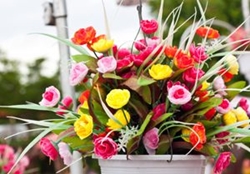
Sales of artificial flowers are enjoying a significant uplift on the back of the longest hay fever season experienced in two decades. Increasing numbers of the estimated 16m Britons who suffer from hay fever are turning to fake flowers as a solution for livening up the home without the symptoms they may experience from some fresh flowers. Responding to the trend, B&Q recently expanded its offer of artificial flowers. And now Sainsbury’s is reporting that demand in its supermarkets has blossomed over the summer, with sales up 222% year on year and 70% up week on week. The retailer says the link with hay fever is so strong it has even found that those buying faux florals are 14 times more likely to buy allergy medicines than the average shopper.

Not to be sniffed at: fake flowers are sneeze-free and sophisticated
Hay-fever-friendly fresh flowers have also enjoyed a rise in sales at Sainsbury’s, with sales of sneeze-safe carnations up 21% on last year. They are recommended for sufferers as the dense petals keep the pollen-distributing anther hidden away.
Improved designs and quality of artificial flowers mean that the plastic offerings reminiscent of 1970s restaurants have today been replaced by realistic fabric styles.
“Designs have improved immeasurably so that now, the only way to tell that the flowers are not real is by touch,” says Emma Mann, design manager at Sainsbury’s. “We think fake flowers are blooming marvellous. All they need is a quick dust every so often and they will last for ever.”
The most popular artificial flowers at Sainsbury’s are agapanthus in a glass bottle, lavender in an enamel trough and hydrangea in a jug. Top hay-fever-friendly fresh flowers are carnations, roses and orchids.
Hay fever can be caused by tree pollen released in spring, grass pollen released in summer and weed pollen released from early spring to late autumn, meaning there is little respite for hay fever sufferers.
In particular, the current sunshine and showers weather has resulted in massive growth of grass and weeds and increased release of their pollens into the air.
Pollen contains proteins that can cause the nose, eyes, throat and sinuses to become swollen, irritated and inflamed.
Source: DIY Week – Hay Fever Drives Boom In Sales of Fake Flowers





